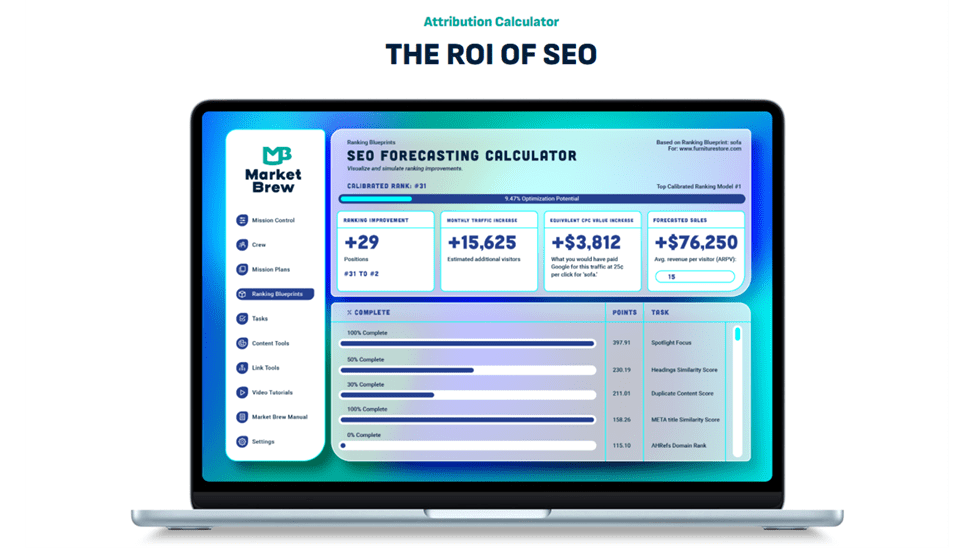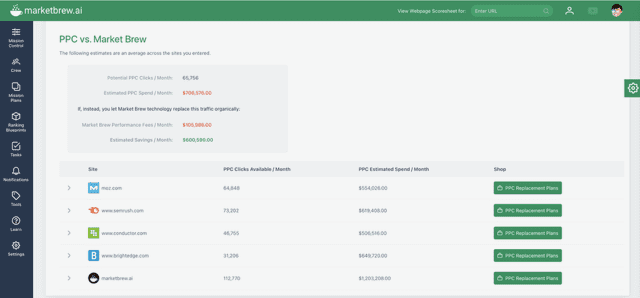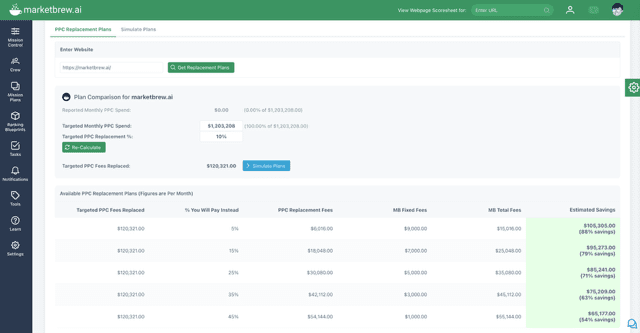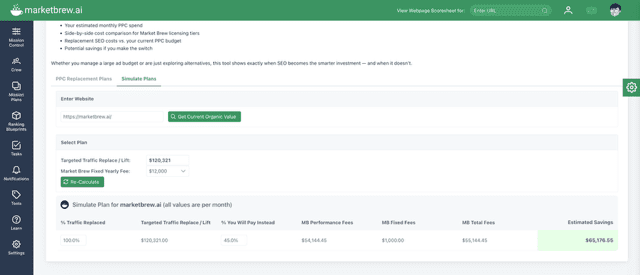The Great Reversal: Why Agencies Are Replacing PPC With Predictable SEO via @sejournal, @mktbrew
This post was sponsored by Market Brew. The opinions expressed in this article are the sponsor’s own.
What if your client’s PPC budget could fund long-term organic growth instead?
Why do organic results dominate user clicks, but get sidelined in budget discussions?
Organic Drives 5x More Traffic Than PPC. Can We Prove It?
The Short Answer: Yes!
Over the past decade, digital marketers have witnessed a dramatic shift in how search budgets are allocated.
In the past decade, companies were funding SEO teams alongside PPC teams. However, a shift towards PPC-first has dominated the inbound marketing space.
Where Have SEO Budgets Gone?
Today, more than $150 billion is spent annually on paid search in the United States alone, while only $50 billion is invested in SEO.
That’s a 3-to-1 ratio, even though 90% of search clicks go to organic results, and only 10% to ads.
It’s not because paid search is more effective. Paid search is just easier to measure.
But that’s changing with the return of attribution within predictive SEO.
What Is Attribution?
Attribution in marketing is the process of identifying which touchpoints or channels contributed to a conversion or sale.
It helps us understand the customer journey so we can allocate budget more effectively and optimize campaigns for higher ROI.
As Google’s algorithms evolved, the cause-and-effect between SEO efforts and business outcomes became harder to prove.
Ranking fluctuations seemed random. Timelines stretched.
Clients became impatient.
Trackable Digital Marketing Has Destroyed SEO
With Google Ads, every dollar has a direct, reportable outcome:
- Impressions.
- Clicks.
- Conversions.
SEO, by contrast, has long been:
- A black box.
As a result, agencies and the clients that hire them followed the money, even when SEO’s results were higher.
PPC’s Direct Attribution Makes PPC Look More Important, But SEO Still Dominates
Hard facts:
- SEO drives 5x more traffic than PPC.
- Companies pay 3x more on PPC than SEO.
 Image created by MarketBrew, August 2025
Image created by MarketBrew, August 2025You Can Now Trace ROI Back To SEO
As a result, many SEO professionals and agencies want a way back to organic. Now, there is one, and it’s powered by attribution.
Attribution Is the Key to Measurable SEO Performance
Instead of sitting on the edge of the search engine’s black box, guessing what might happen, we can now go inside the SEO black box, to simulate how the algorithms behave, factor by factor, and observe exactly how rankings react to each change.
This is SEO with attribution.



With this model in place, you are no longer stuck saying “trust us.”
You can say, “Here’s what we changed. Here’s how rankings moved. Here’s the value of that movement.” Whether the change was a new internal link structure or a content improvement, it’s now visible, measurable, and attributable.
For the first time, SEO teams have a way to communicate performance in terms executives understand: cause, effect, and value.
This transparency is changing the way agencies operate. It turns SEO into a predictable system, not a gamble. And it arms client-facing teams with the evidence they need to justify the budget, or win it back.
How Agencies Are Replacing PPC With Measurable Organic SEO
For agencies, attribution opens the door to something much bigger than better reporting; it enables a completely new kind of offering: performance-based SEO.
Traditionally, SEO services have been sold as retainers or hourly engagements. Clients pay for effort, not outcomes. With attribution, agencies can now flip that model and say: You only pay when results happen.
Enter Market Brew’s AdShifted feature to model this value and success as shown here:
The AdShift tool starts by entering a keyword to discover up to 4* competitive URLs for the Keyword’s Top Clustered Similarities. (*including your own website plus 4 top-ranking competitors)



- Screenshot of PPC vs. MarketBrew comparison dashboard by Marketbrew, August 2025
AdShift averages CPC and search volume across all keywords and URLs, giving you a reliable market-wide estimate and details for your brand towards a monthly PPC investment to rank #1.



- Screenshot of a dashboard by Marketbrew, August 2025
AdShift then calculates YOUR percentage of replacement for PPC to fund SEO.
This allows you to model your own Performance Plan with variable discounts available to the Market Brew license fees with an always less than 50% of PPC Fee for clicks replaced by new SEO traffic.



- Screenshot of a dashboard by Marketbrew, August 2025
AdShift simulates a PPC replacement plan option selected based on its keywords footprint to instantly see savings from the associated Performance Plans.
That’s the heart of the PPC replacement plan: a strategy you can use to gradually shift a clients’ paid search budgets into measurable performance-based SEO.
What Is A PPC Replacement Plan? Trackable SEO.
A PPC replacement plan is a strategy in which agencies gradually shift their clients’ paid search budgets into organic investments, with measurable outcomes and shared performance incentives.
Here’s how it works:
- Benchmark Paid Spend: Identify the current Google Ads budget, i.e., $10,000 per month or $120,000 per year.
- Forecast Organic Value: Use search engine modeling to predict the lift in organic traffic from specific SEO tasks.
- Execute & Attribute: Complete tasks and monitor real-time changes in rankings and traffic.
- Charge on Impact: Instead of billing for time, bill for results, often at a fraction of the client’s former ad spend.
This is not about replacing all paid spend.
Branded queries and some high-value targets may remain in PPC. But for the large, expensive middle of the keyword funnel, agencies can now offer a smarter path: predictable, attributable organic results, at a lower cost-per-click, with better margins.
And most importantly, instead of lining Google’s pockets with PPC revenue, your investments begin to fuel both organic and LLM searches!
Real-World Proof That SEO Attribution Works
Agencies exploring this new attribution-powered model aren’t just intrigued … they’re energized. For many, it’s the first time in years that SEO feels like a strategic growth engine, not just a checklist of deliverables.
“We’ve pitched performance SEO to three clients this month alone,” said one digital strategy lead. “The ability to tie ranking improvements to specific tasks changed the entire conversation.”
Another partner shared,
“Instead of walking into meetings looking to justify an SEO retainer, we enter with a blueprint representing a SEO/GEO/AEO Search Engine’s ‘digital twin’ with the AI-driven tasks that show exactly what needs to be changed and the rankings it produces. Clients don’t question the value … they ask what’s next.”
– Stephen Heitz, Chief Innovation Officer, LAVIDGE
Several agencies report that new business wins are increasing simply because they offer something different. While competitors stick to vague SEO promises or expensive PPC management, partners leveraging attribution offer clarity, accountability, and control.
And when the client sees that they’re paying less and getting more, it’s not a hard sell, it’s a long-term relationship.
A Smarter, More Profitable Model for Agencies and SEOs
The traditional agency model in search has become a maze of expectations.
Managing paid search may deliver short-term wins, but it comes to a bidding war with only those with the biggest budgets winning. SEO, meanwhile, has often felt like a thankless task … necessary but underappreciated, valuable but difficult to prove.
Attribution changes that.
For agencies, this is a path back to profitability and positioning. With attribution, you’re not just selling effort … you’re selling outcomes. And because the work is modeled and measured in advance, you can confidently offer performance plans that are both client-friendly and agency-profitable.
For SEOs, this is about getting the credit they deserve. Attribution allows practitioners to demonstrate their impact in concrete terms. Rankings don’t just move, … they move because of you. Traffic increases aren’t vague, … they’re connected to your specific strategies.
Now, you can show this.
Most importantly, this approach rebuilds trust.
Clients no longer have to guess what’s working. They see it. In dashboards, in forecasts, in side-by-side comparisons of where they were and where they are now. It restores SEO to a place of clarity and control where value is obvious, and investment is earned.
The industry has been waiting for this. And now, it’s here.
From PPC Dependence to Organic Dominance — Now Backed by Data
Search budgets have long been upside down, pouring billions into paid clicks that capture a mere fraction of user attention, while underfunding the organic channel that delivers lasting value.
Why? Because SEO lacked attribution.
That’s no longer the case.
Today, agencies and SEO professionals have the tools to prove what works, forecast what’s next, and get paid for the real value they deliver. It’s a shift that empowers agencies to move beyond bidding-war PPC management and into a lower cost & higher ROAS, performance-based SEO.
This isn’t just a new service mode it’s a rebalancing of power in search.
Organic is back. It’s measurable. It’s profitable. And it’s ready to take center stage again.
The only question is: will you be the agency or brand that leads the shift or watch as others do it first?
Citations
Image Credits
Featured Image: Image by Market Brew. Used with permission.
In-Post Image: Images by Market Brew. Used with permission.












